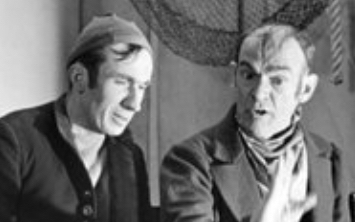OTD in early British television: 2 April 1939

John Wyver writes: Television on the afternoon of Sunday 2nd April was mostly occupied by the 40-minute feature Leviathan, described as ‘a survey of sea-monsters, past and present’. A discussion between Lt-Commander R.T. Gould, author of The Case for the Sea-Serpent, and London zoo curator David Seth-Smith framed dramatised scenes (above, and in full below) bearing witness to tales of beings from the deep.
Apparently Lt-Commander Gould had told Picture Page viewers the previous October that he was a firm believer in the existence of sea monsters, and in this programme producer Stephen Harrison offered him the chance to expound his views more fully. What intrigues me most about the transmission, however, is the writer credited for the dramatised scenes, Reyner Heppenstall.

Yorkshireman Heppenstall established himself in the literary London of the 1930s, when he was in his mid-20s, hanging out with John Middleton Murray, Eric Gill, Dylan Thomas and George Orwell, with whom he shared a flat in Camden. The same year as Leviathan, he published his first novel, The Blaze of Noon. For two decades after the war he worked as a features and later drama producer for BBC radio, adapting Orwell’s Animal Farm in 1947.
In 2007 filmmaker and critic Juliet Jacques wrote a study of Heppenstall’s early novels, which on her website she describes in this way:
This book examines the first five novels by Heppenstall, published between 1939 and 1962, using Hélène Cixous’s claim that Heppenstall’s first, The Blaze of Noon (1939), inaugurated the nouveau roman as a starting point. It asks why Heppenstall fell out of print when several of his ‘experimental’ British contemporaries (such as B. S. Johnson, Ann Quin or Christine Brooke-Rose) maintain a higher critical reputation, situating him within the modernist and neo-modernist movement of mid-20th century Britain and France.

In a fascinating article for 3AM magazine, Jacques also wrote:
Heppenstall spent the Thirties, like many of his contemporaries, searching for an intellectual doctrine that suited him, and the absence of dogma separated The Blaze of Noon from much late-Thirties literature.
What really distinguished it, however, was its unique approach to narration. Protagonist Louis Dunkel’s blindness necessitated extensive descriptions of the physical properties of objects, including people, attempting to compensate for the lack of non-verbal communication with ceaseless analysis…
The Blaze of Noon was “not the work of a literary theorist,” Heppenstall later wrote; his sole theoretical principle was that film had assumed the nineteenth-century novel’s exteriorised narrative function and that literary prose “would do well to become more lyrical, more inward.”
Presumably, Heppenstall’s work on Leviathan was simply hack-work for hire, since he wrote nothing else for pre-war television, but it is an intriguing little link between the early medium and the lost-war literary avant-garde.
Leave a Reply